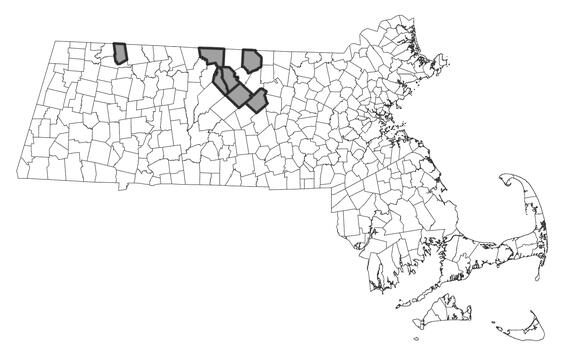- Scientific name: Gentiana linearis Froel
Species of Greatest Conservation Need (MA State Wildlife Action Plan)
Description
Narrow-leaved gentian is an uncommon perennial herb with distinctive bright blue flowers. It has narrow leaves and grows up to 80 cm (31 in) in height but can be as short as 20 cm (8 in). Like the closely related Andrews’ Bottle gentian (Gentiana andrewsii), this species has flowers that do not appear to open. Thus, pollinators are restricted to the powerful bumblebees that can force their way into the flower.
Narrow-leaved gentian can be distinguished in Massachusetts from other bottle gentians by having entire, smooth leaves (no teeth) even at the margins. Other species have cilia at the margins. Cilia are fine hairs, visible with 5-power or more magnification. This species also has narrow leaves that rarely are as wide as 1 cm (<0.5 in). The leaves are dark green and up to 9 cm (3.5 in) in length. They are narrowly lanceolate and narrow toward the base.
Narrow-leaved gentian is similar to the other two bottle gentian species in Massachusetts, Gentiana andrewsii (Andrews’ bottle gentian) which is a state Endangered species, and Gentiana clausa (closed gentian), both of which have abundant cilia on the leaf margins.
Life cycle and behavior
This is a perennial herb that is pollinated by bumblebees. It blooms from late July into mid-September.
Population status
Narrow-leaved gentian is a species of greatest conservation need and is maintained on the plant watch list. It has been verified in 16 locations since 1999. It has been observed primarily in Franklin and northern Worcester Counties.
Distribution and abundance
Narrow-leaved gentian is primarily a species of New Hampshire, Maine, and eastern parts of Canada, but also ranges rarely down into the southern Appalachians.

Distribution in Massachusetts. 2000-2025. Based on records in the Natural Heritage Database.
Habitat
Narrow-leaved gentian prefers, but is not always found in, wet habitats, sometimes along wet road edges. It is found in acidic wetlands, boggy habitats, as well as floodplains, wet meadows, and the shores of lakes and rivers, including beaver ponds. It has a wetland status of FACW in the New England states (FACW stands for “Facultative Wet” and is one of 5 ranks that are given to plants to state how likely they are to be found within wetlands. This ranking system is heavily used by wetland scientists. FACW means that approximately 67% of the time this will be found in a wetland system, while 33% it will be found in an upland).
Healthy habitats are vital for supporting native wildlife and plants. Explore habitats and learn about conservation and restoration in Massachusetts.
Threats
Since this is a wetland species, threats to the narrow-leaved gentian include disruption of the natural hydrologic regime, as well as habitat loss, deer browse, invasive species, and climate change. Inputs of nutrients from farm or lawn fertilizers, as well as excess flooding and siltation may increase the abundance of invading exotic (or aggressive native) plants such as purple loosestrife (Lythrum salicaria), common reed (Phragmites australis ssp. australis), cattail (Typha spp.) and reed canary grass (Phalaris arundinacea).
Contact
| Date published: | April 29, 2025 |
|---|